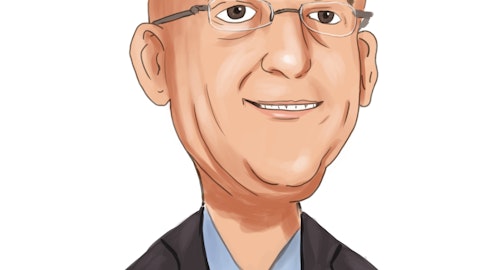Provident Financial Services, Inc. (NYSE:PFS) Q3 2023 Earnings Call Transcript October 27, 2023
Operator: Good morning. My name is Rob, and I will be your conference operator today. At this time, I would like to welcome everyone to the Provident Financial Services, Inc. Third Quarter 2023 Earnings Conference Call. [Operator Instructions] Thank you. Adriano Duarte, Investor Relations Officer, you may begin your conference.
Adriano Duarte: Thank you, Rob. Good morning, everyone, and thank you for joining us for our third quarter earnings call. Today’s presenters are President and CEO, Tony Labozzetta; and Senior Executive Vice President and Chief Financial Officer, Tom Lyons. Before beginning the review of our financial results, we ask that you please take note of our standard caution as to any forward-looking statements that may be made during the course of today’s call. Our full disclaimer is contained in last night’s earnings release, which has been posted to the Investor Relations page on our website, provident.bank. Now it’s my pleasure to introduce Tony Labozzetta, who will offer his perspective on our third quarter. Tony?
Tony Labozzetta: Thank you, Adriano. Good morning, everyone, and welcome to the Provident Financial Services earnings call. The third quarter was marked by rising interest rates and persistent inflationary pressures. These conditions have presented substantial challenges to many in the banking sector. Against that backdrop, I’m pleased to report that Provident has demonstrated its resilience and agility, delivering results that point towards the underlying strength of our operation and our commitment to responsible growth. Despite the difficult economic environment, Provident produced good financial results this quarter, which once again demonstrates the strength of the franchise and talented management team. As such, we reported earnings of $0.38 per share, an annualized return on average assets of 0.81% and a return on average tangible equity of 9.47%.
Excluding merger-related charges, our core pretax pre-provision return on average assets was 1.48%. At quarter end, our capital was strong and exceeded well-capitalized levels. Tangible book value per share was $15.41 and our common — tangible common equity ratio was solid at 8.54%. As such, our Board of Directors approved a quarterly cash dividend of $0.24 per share payable on November 24. Presently, our uninsured and uncollateralized deposits are $2.5 billion or approximately 25% of our total deposits. Our on-balance sheet liquidity plus borrowing capacity is $3.6 billion or 144% on insured deposits. Our core deposits are a valuable component of our franchise. During the quarter, our average core deposits decreased $85 million or 0.9%, which we attribute to normal business activities and customers seeking higher-yielding investment alternatives in this environment.
Our rising rate cycle to date deposit data was approximately 29.5%, which we believe is among the best in the peer group and is reflective of the quality of our deposit base. Consequently, our total cost of deposits increased and in large part, drove our total cost of funds up 33 basis points to 2.04%, compressing our net interest margin 15 basis points to 2.96%. Our commercial lending team closed approximately $330 million of new commercial loans during the third quarter. Payoffs decreased 16% to about $94 million as compared to the trailing quarter. Our credit metrics continue to be excellent in the third quarter, and we are maintaining prudent underwriting standards, particularly in CRE lending. As part of our normal pre-monitoring processes, we have performed targeted in-depth analysis to evaluate portfolio segments concentration and loan level risk.
These enhanced evaluations of our portfolio have not indicated any meaningful deterioration despite difficulties in the wider market. Our line of credit utilization percentage decreased 1.9% in the third quarter to 33%, remaining below our historical average of approximately 40%. As a result of the improved production and reduced prepayments, offset by a decreased line of credit utilization, our commercial loans grew approximately $134 million or 1.48% for the quarter. For the 9 months, we grew $296 million or 4.9%, which is pacing at an annualized growth rate of about 6.5%. The pull-through in our commercial loan pipeline during the third quarter was good and the gross pipeline remained strong at approximately $1.7 billion. The pull-through adjusted pipeline, including loans pending closing, is approximately $1.1 billion, and our projected pipeline rate increased 39 basis points to 7.62%.
We are encouraged by the strength and quality of our pipeline. In addition, payoffs have slowed and as a result, we expect to achieve our commercial lending growth targets for the remainder of 2023. Our fee-based business has performed well. Despite a hardening insurance market, Provident Protection Plus had a strong third quarter with 63% organic growth which resulted in an 11.9% increase in revenue and a 12.3% increase in operating profit as compared to the same quarter last year. Beacon Trust performed in line with expectations as conditions in the financial markets continue to remain volatile. Fee income remained stable despite the reduction in assets under management, which was due in part to market conditions. Beacon’s investment performance compares favorably to the applicable benchmarks.
With respect to our previously announced merger with Lakeland Bancorp, we are continuing our engagement with the regulators and have complied with all information requested, and now we await final approval of the merger. The companies have made significant progress in various integration initiatives through outstanding team works from both banks. While regulatory approval is not within our control, preparations for our merger with Lakeland continues to progress as both companies eagerly await approval. As we look forward, we remain focused on growing and strengthening the fundamentals of our business. However, being disciplined and remaining committed to our responsible risk management principles is critical during these challenging times. While we await for regulatory approval, we expect to close and integrate the merger with Lakeland Bank in the near future, which we believe will create value for all of our stakeholders.
Now I’ll turn the call over to Tom for his comments on our financial performance. Tom?
Tom Lyons: Good morning, everyone. As Tony noted, our net income for the quarter was $28.5 million or $0.38 per share compared with $32 million or $0.43 per share for the trailing quarter and $43.4 million or $0.58 per share for the third quarter of 2022. Transaction charges related to our pending merger with Lakeland Bancorp totaled $2.3 million in the current quarter or approximately $0.03 per share and $2 million in the trailing quarter. Excluding these merger-related charges, pretax pre-provision earnings for the current quarter were $52.2 million or an annualized 1.48% of average assets. Revenue totaled $116 million for the quarter compared with $118 million for the trailing quarter and $138 million for the third quarter of 2022.
Please note, prior year earnings for the third quarter of 2022 included an $8.6 million gain on the sale of foreclosed property. Our net interest margin decreased 15 basis points from the trailing quarter to 2.96%. The yield on earning assets improved by 16 basis points versus a trailing quarter as floating and adjustable rate loans repriced favorably and new loan originations reflected higher market rates. This improvement in asset yields, however, was more than offset by an increase in interest-bearing funding costs. Increased funding costs reflected current market conditions, which resulted in an increase in borrowings accompanied by a decrease in deposits. Certain noninterest-bearing balances also moved to our interest-bearing insured cash sweep product in order to obtain increased deposit insurance.
In addition, lower costing demand and savings balance has shifted to higher costing time deposits. The average total cost of deposits increased 32 basis points in the trailing quarter to 1.74%. This brought our rising rate cycle to date beta to 29.5%. The average cost of total interest-bearing liabilities increased 37 basis points in the trailing quarter to 2.50%. The prolonged inverted yield curve, ongoing deposit competition and an increase in the attractiveness of investment alternatives continue to impact funding costs. As a result, we expect to see some continued net interest margin compression for the balance of 2023 and currently project the margin will stabilize in Q4 at around 2.90%. Period-end total loans grew $137 million driven by multifamily mortgage loan originations.
Our pull-through adjusted loan pipeline increased $75 million from last quarter to $1.1 billion, with a weighted average rate of 7.62% versus our current portfolio yield of 5.37%. Asset quality remains strong with nonperforming loans as a percentage of total loans falling to 37 basis points and both early stage and total delinquencies improving. Criticized and classified loans did increase slightly this quarter but were still low at 1.7% of total loans. Net charge-offs were $5.5 million or an annualized 21 basis points of average loans this quarter bringing year-to-date net charge-offs to 9 basis points. The current quarter loss was driven by a single C&I loan impacted by a strategic business shift implemented by a primary customer. The provision for credit losses on loans increased $0.6 million for the quarter to — sorry to $11 million, primarily due to a weakened economic forecast within our CECL model.
As a result, the allowance for credit losses on loans increased to 101 basis points of total loans at September 30 from 97 basis points at June 30. Noninterest income remained steady, decreasing only $67,000 versus the trailing quarter. Excluding provisions for credit losses on commitments to extend credit and merger-related charges, noninterest expense was consistent with the trailing quarter at $63.3 million, representing an annualized 1.8% of average assets for the current quarter compared with 1.83% in the trailing quarter and 1.89% for the third quarter of 2022. The efficiency ratio was 54.81% for the third quarter of 2023 compared with 53.29% in the trailing quarter and 47.11% for the third quarter of 2022. Our effective tax rate declined to 23.7% this quarter as a result of a decrease in projected taxable income.
We expect the fourth quarter effective tax rate of approximately 25.5%. That concludes our prepared remarks. We’d be happy to respond to questions.
See also 12 Best Vanguard ETFs for Portfolio Diversification and 25 Biggest Stocks with Negative Beta.
Q&A Session
Follow Provident Financial Services Inc (NYSE:PFS)
Follow Provident Financial Services Inc (NYSE:PFS)
Operator: [Operator Instructions] Your first question today comes from the line of Mark Fitzgibbon from Piper Sandler.
Mark Fitzgibbon: Happy Friday. Tom, just to clarify on the margin, I think you said you expect it to stabilize around [2.90%] in the fourth quarter. So do you think at that point, the margin will have bottomed? .
Tom Lyons: That’s what our model is showing. It stays pretty stable at around the [2.90%] level over the course of the next 12 months, Mark.
Mark Fitzgibbon: And then secondly, you mentioned in the press release a little bit about sort of triggering events and testing for goodwill impairment. Can you explain exactly what a triggering event would be, what the consideration would be that would cause an interim goodwill impairment test?.
Tom Lyons: I think a lot of it, Mark, is the relative performance to the group. If you see price to book multiples, very materially or price to tangible multiples that would indicate any kind of permanent impairment — permanent is a stronger word, but near-term impairment and the valuation of the company.
Mark Fitzgibbon: And then on credit, you guys were one of the few banks that showed a sequential quarter decline in Provident loans, which is great. I guess I was curious, are there any areas that you’re paying particular attention to aside from the obvious office loans that everybody talks about. Any areas that you’re sort of watching carefully or pairing exposures or things of that nature?
Tony Labozzetta: Mark, it’s Tony. We’ve done — I would say we’ve probably spent the better part of 6 to 9 months doing deep dives in all categories. I could comfortably state right now that there’s not any segments that we’re seeing that present any concern to us. In fact, the results show that there’s no systemic pressure. I mean, in any of the segments. Obviously, you’re familiar with that we don’t have a lot of exposure in office as we noted, but we’re comfortable with the way our assets are classified at this time. Obviously, I always have to put the caveat. We don’t know what recessions. We don’t know if bankruptcies take place, things of that nature. But what we’re observing right now do not point to any sectors that we have a concern within our portfolio.
Tom Lyons: The only additional thing I’d offer, Mark, is that the nonperforming asset formation this quarter was very small. It’s about $2.5 million and it’s really attributable to one $3 million loan that I’m very confident there’s no loss content, and it’s a technical maturity issue.
Mark Fitzgibbon: And then last question. Tony, you’ve probably seen that several other banks have recently sold their insurance agency businesses at fairly large gains. I wondered if you could share with us your thoughts on the possibility of doing something like that, whether it would make sense or not.
Tony Labozzetta: Well, we look at all of our businesses with an annual frequency. I would say when it comes to insurance, it’s such an integral part of our business the way it links with our commercial platform, the rate of growth, the value add that it provides to our customers that at this time, it’s not in our consideration, and it’s probably one of our largest growing segments. So I think the combination of those things, just to turn it into a financial transaction, I think it will be a net takeaway from our client experience and the rate of growth in our noninterest income. By the way, as we’ve spoken in the past, as many know, it is our objective to increase the percentage of noninterest income as a percentage of total revenue. So that has taught us an important piece of business that is not considered for sale right now.




